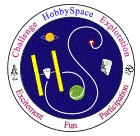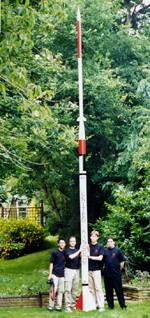|
April
30, 2003
Space
Access ' 03 Review includes synopses of some advanced
rocketry related talks.
JAMSTAR
images and videos are now
online from the successful night launching on April 20th of
their 80,000 N-s P motor. (Thanks to Kaido Kert for the tip.)
News
brief... Saw this link posted at ERPS
about the paraffin
hybrids in development at Stanford : Refueling
Rockets : Could spacecraft powered by a new wax be safer and cheaper?
- Science News - Mar.22.03
April
23, 2003
Environmental
Aerosciences press release in RLV News
April
22, 2003
Time
to contact Congress to save rocketry - Space Log
April
21, 2003
JAMSTAR
success! Joseph Pearce, head of communications and EE
for the Jamstar launch informs me that the JAMSTAR
launch
"was
successful… our antenna and power was broken shortly after apogee
so it will take us a few days to analyze the onboard computers
before we can give an exact altitude. We recovered everything
but the fin can before noon of the next morning (no sleep that
night!). I must say it was the most amazing thing I’ve ever been
a part of."
Congratulations
to the JAMSTAR team!
April
20, 2003
Advance
Rocketry Records, Achievements & Competitions...With
the help of Andrew Case, a new
page on records, general achievements and competitions
in advanced rocketry is now available.
Besides the
highest and the near highest, we want to include all sorts of notable
accomplishments in this area. If you want to suggest and addition,
please contact HobbySpace.
JAMSTAR
launch? Waiting for word on whether the scheduled launch
of the JAMSTAR
student rocket happened last night. In the meantime, check out this
article : Go
for launch --and the record books? - OrlandoSentinel - Apr.20.0
April
19, 2003
eAc
reveals its new project... The rollout of the Scaled
Composites SpaceShipOne yesterday also revealed the project
that eAc mentioned
below: it is competing to win the hybrid motor contract. See the
page at Tier
I for details.
April
18, 2003
Open
source space ... Michael Mealling at RocketForge
talks about the possibilities of applying the open source software
approach to rocketry and other space project development : From
Buck and Wernher to Erik Raymond and Linus Torvalds - RocketForge
- Apr.16.03. Andrew Case, John McKnight and others have posted
interesting comments.
April
16, 2003
New
eAc hybrid rocket project ... Environmental
Aerosciences reports:
Environmental
Aeroscience Corp (eAc), inventors of the modern nitrous oxide
hybrid, markets their HPR version under the trade name HyperTEK.
HyperTEK is the leader in High Power hybrid rocket propulsion.
As a continuation of our nitrous oxide hybrid development, eAc
has become involved in several projects,
including the Hyperion I sounding rocket launch to over 20 miles,
the development of a 5000 lb thrust, 35 second burn hybrid for
the next generation Hyperion II, and an 11,000 lb thrust, 12 second
hybrid for the MuLV.
We are now
involved in a very exciting new program of interest to all rocketeers.
The
details will be released on our website hybrids.com
on Friday April 18th at 5pm under the projects
link.
April
11, 2003
JAMSTAR
night launch ... Jeff Taylor posted the following item
today on the ARocket forum:
Project update:
We had some problems with the FAA on this one, first they said
yes, then they said no to our requested 100,000 foot waiver. They
finally gave us the go ahead with one stipulation; we have to
launch at night. Yowza!A full 80,000 N-s P motor at night! That's
my kind of stipulation! With burnout at 30,000+ feet we weren't
going to be able to see it after that even in broad daylight.
The night launch makes recovery more difficult, but we'll take
it!
Our first
launch window is 2am-3am Sunday April 20th. It's been a lot of
fun helping out with this project and I'm very excited to see
this one fly. I doubt I'll sleep much this week.
Read about
the Florida Institute of Technology student project JAMSTAR here:
www.fit.edu/projects/jamstar/index.html
See also the
item on March 31, 2003
about the JAMSTAR project.
April
10, 2003
Peroxide
shortage... This thread - Peroxide
- on the ERPS
board discusses the worsening problems in obtaining high purity
hydrogen
peroxide by small rocketry organizations.
Australian
Experimental
offers "both amateur and professional researchers with a unique
set of products devoted to a highly specialized field that is experimental
rocket propulsion."
April.9.03
Other
Advanced technical hobbies vs rocketry... Andrew Case
said I could reprint here his posting on sci.space.tech about how
the current state of advanced rocketry compares to other advanced
technical hobbies. This posting was in response to the announcement
by Geoffrey Landis of a page describing the history of the Spacecub
suborbital rocket design - Remembering
SpaceCub.
I've been
looking at other areas where ambitious amateurs build cool stuff
like submarines, aircraft, hovercraft, boats, etc. The common
threads appear to be that most of the work is non-technical (buy
engines, avionics, scrubbers, etc), and the mid-to-high end is
about $150,000 in expenses and ~2000-3000 man hours, spread over
about 5 years. Also there tends to be a large(ish) community of
people building from established kits or plans, and the really
high end builders have usually built a more modest vehicle from
plans or a kit.
To get to
this point with rockets, we need to be able to buy engines. Avionics
can probably be done by rejiggering existing systems, or even
with relatively straightforward cobbling together of COTS components.
Emergency escape is also COTS or hacked-COTS (assuming a simple
parachute based system). Engines, OTOH, are a big deal - you could
easily blow the entire 2000hr/$150,000 time and money budget developing
engines reliable enough to trust your life to.
Once somebody
else has blazed the trail, and enough firsthand knowledge is available
within the community to reduce the risk (who wants to spend a
man-year and 2-3 years' salary on something that might not work?)
I think it's likely that SpaceCub-like vehicles could be constructed
within the time and money envelope of other ambitious amateur
projects. The path from here to there needs trailblazers (like
the various X-Prize teams), and it needs companies willing to
sell rocket engines to people tinkering in their garages.
At this point,
the only engines that come up regularly for sale appear to be
Atlas verniers, but the thrust on these is so low that you'd have
to cluster a bunch of them, leading to a plumbers nightmare and
a high parts count, with all the reliability implications that
has. It'd be really nice to have a high reliability throttleable
engine in the 5klb thrust range - that's right about where you
need to be for SpaceCub type vehicle with 5 engines. If the price
matched the Atlas verniers on a per lb thrust basis you'd end
up paying around $25,000-$40,000, which is about right relative
to the total as compared to what other ambitious amateur vehicle
builders pay for their purchased subsystems.
April
4, 2003
Aerospike
motor test flight ... The latest issue of Aviation Week
(Mar.31.03) reports on the success of an aerospike
nozzle on a small commercial rocket. JP Rocket Engines
(no web link found yet) of Salt Lake City, Utah recently launched
an Aerotech rocket
with a cone-shaped aerospike with 5 holes around the base of the
spike for exhaust from the solid rocket motor. With no outer nozzle
wall to contain it, the plume expands continuously as atmospheric
pressure decreases with altitude and thus provides more efficient
thrust throughout the flight.
The company
claims that in comparing altitude and climb performance between
the aerospike and the conventional bell nozzle, the aerospike provided
37% greater efficiency.
Aerospikes nozzles
got a boost in publicity a few years ago when the X-33
aerospike engine program successfully tested them. The
self-compensating altitude thrust of aerospikes makes them ideal
for single-stage-to-orbit. However, as this test shows, even for
low altitude and suborbital rockets they could provide greater performance.
Note that other
advanced rocketry groups are also looking at aerospikes such as
the Cal
State Long Beach program, which has tested an aerospike with
a liquid fueled engine : Aerospike
Engine Engine Runs for 200 ms Before Plug Breaks-off - CalState
Long Beach/Garvey Spacecraft - Apr.28.02
April.1.03
Advanced
student rocketry in Switzerland... Students at the Swiss
Propulsion Laboratory (SPL) continue to show progress in developing
sophisticated rocket technology as in this recent milestone - First
firing with the regeneratively cooled 2.5 kN LOX/Ethanol engine!
- SPL - Jan.22.03. The group is working towards a 8kN engine
that will power their X-BOW
I sounding rocket.
Mar.31.03
Big
amateur rocket motor test ...
Darren Wright of Ozark
Aerospace has informed me about the successful test of a 80,000Ns
P motor jointly developed with Jeff Taylor of Loki
Research. for the JAMSTAR
project at the Florida
Insitute of Technology.
"The
motor weighed 140lbs and had 82 lbs of propellant, and was 6"
x 8ft long. We got a 8.5 sec burn with a max thrust of 3300lbs.
I believe this is the largest amateur motor ever successfully
fired East of the Mississippi. The rocket is slated to launch
April 19th in southern Florida, and should hit 100,000ft.(35km]"
[Modified from 140k ft Mar.31.03]
See the P-Motor
Mayhem page for photos and videos of the test.
The JAMSTAR
(Joint Aerospace & Meteorlogical Stratosphere Analysis Rocket)
project aims to develop sounding rockets to launch meteorlogical
instrument packages (so-called dropsondes that descend on parachutes)
up to 30 miles (~50km). These will provide useful scientific data
and also train students and develop the capabilities of the FIT
aerospace group.
See the Mission
page for details about JAMSTAR and the rocket, which includes the
first stage booster and an unpowered dart type second stage that
carries the payload.
Mar.23.03
Texas
rocketry project...The Texas based Amateur
Spaceflight Association receives some publicity for its advanced
rocketry projects - High-flying
ambition: Race is on to build first amateur rocket to reach space
- HoustonChronicle.com - Mar.23.03 (link found at spacetoday.net)
March
21, 2003
StarBooster
model test... Calpoly
Space Systems has posted pictures
of the January flight of their scale model version of the Starbooster
RLV system (Buzz Aldrin's concept). It is a a 1/3 scale version
of the Starbooster
Demonstrator,
for which the company got an Air Force SBIR grant last year. [My
thanks to Kaido Kert for this item.]
Prospector
3 launch success... Last Saturday the Cal State Long
Beach/Garvey Spacecraft team
succesfully launched and recovered their Prospector 3 sounding rocket
: Thrust
Vectoring Successfully Demonstrated on P-3 Launch and Recovery -
CSULB - Feb.22.03.
The
flight provided an "initial demonstration of thrust vector
control, an improved engine chamber design and the first use of
a new set of flight control avionics." Videos will be made
available of the flight later.
February
22, 2003
Launch
planned for student rocket with thrust vectoring ...
A launch of the Prospector 3 by California
State University, Long Beach and Garvey
Spacecraft Corporation (GSC) is planned for this weekend. It
will take place at the Mojave Test Area, site owned and operated
by the Reaction Research
Society.
According
to the CSULB
web site:
"The
flight is scheduled to include take-off with a 500 lbf engine
(using LOX and ethanol) followed by a nose down then nose up pitch
maneuver. The thrust vector control system will be an open loop
control system acting only in one axis and will serve to generate
data on rocket dynamics and compare these with analytical model
predictions for integration into the 2-axis closed-loop control
system to be flown at a later date.
"The
Prospector-3 rocket will also fly two sets of payloads developed
by USC students involved in the USC
Microsatellite Program. One of these payloads will be bonding
samples to test this technology for use in MEMS applications.
The other will be a flight computer and launch environment (including
high frequency accelerometers) data recording system."
See
info on previous launchings of the Prospector series at Garvey's
Kimbo Rockets
site.
Feb.18.03
Rocket
Inaugurates Texas Spaceport... Mark Goll's Texas
Spacelines company launched a high power hybrid rocket to initiate
activities at a new spaceport
taking shape in southeast Texas : Taking
Flight: Elected leaders and officials gathered to witness event
- Valley Morning Star - Feb.18.03 . More about the launch and
Texas Spacelines in the advanced
rocketry section. (Thanks to spacetoday.net
for links to articles about the launch.)
Jan.30.03
Texas
Rocketeers...
The Amateur Spaceflight
Association, based in Houston, will launch its advanced solid
rocket powered A1/2
on Saturday, February 8th "from the Gulf Coast Regional Spaceport
in Brazoria County." The ~550kg vehicle should reach 4.5km
(15000ft).
The A1/2 is
a half scale version of the LOX/Kerosene powered A1,
which they hope to launch in the fall of this year. They aim for
this ~900kg vehicle to reach an altitude of 120km (75mile) and thus
set a new record for amateur rocketry.
Jan.9.03
SORAC
Back On line - the S.O.R.A.C.
(Sub-Orbital Rocket Amateur Class) project has
its site back up. I lost track of this group, which had been a competitor
in the CATS
contest, when its web site went down for a long period. Recently
leader Bill Colburn informed me that the site was back up and the
group (10 core staff and 20 volunteers) has several projects in
the works. For example,
"SORAC,
in conjunction with Micro Aerospace Solutions, has gotten a contract
for studying Gelled Propellants from NASA. This is our fourth
contract, the other three being from Stanford Research Institute
for Gas Generators and research on Thermitic Materials....
... We will
be testing at M K Ballistic Systems and Rocket Ranch."
The group focuses
on hybrid rockets. I look forward to following their progress.
Find more about
SORAC and other such projects in the Advanced
Rocketry section.
|



